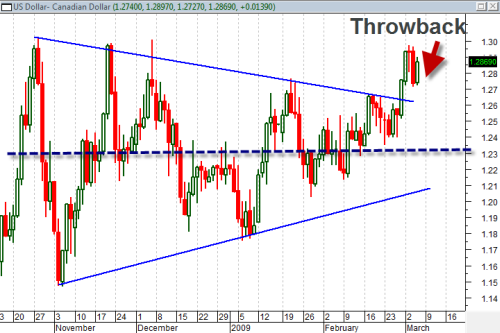Working successfully in the markets means you are good at being wrong.
A common complaint we hear from new traders at LearningMarkets is after a trade is entered the market will often reverse just far enough to stop them out before yo-yoing again and breaking out in the originally forecasted direction. These reversals (also known as whipsaws, fakeouts or throwbacks) are a frustrating experience but can be handled more effectively through some additional planning.
Video Analysis: Dealing With Throwbacks, Whipsaws and Fakeouts
A throwback can be defined as a retracement following a pattern breakout that stops at a support level and then bounces back towards the profit target it is common experience. Testing has shown that a throwback will happen in about 20% of all pennant breakouts.
When you add that to the typical failure rate of a pennant breakout, an unprepared trader could be losing in a majority of their trades based on this pattern.
Knowing that a throwback could happen gives you something to plan for. The image below is a classic example of an emerging throwback. The USD/CAD broke out of its consolidation pennant on 2/27/2009 and subsequently has retraced back towards the support level of the top pennant barrier. Besides the top of the pennant another two logical support levels can be estimated at the midpoint of the pattern and the prior low.
Planning for the throwback helps you make better estimates for where a stop loss could be placed. This specific setup was the subject of a video about projecting pennant breakouts earlier. The projections show a potential upside in the 1.54-156 range. Establishing a stop loss near 1.21 as protection against a breakdown is not disproportionately large compared to the projected upside.
Planning your trade involves more than just finding the buy signal. Proper planning should include projections, potential throwbacks, stop losses and money management. You can learn more about this in the video that accompanies this article.
USD/CAD Daily Chart
